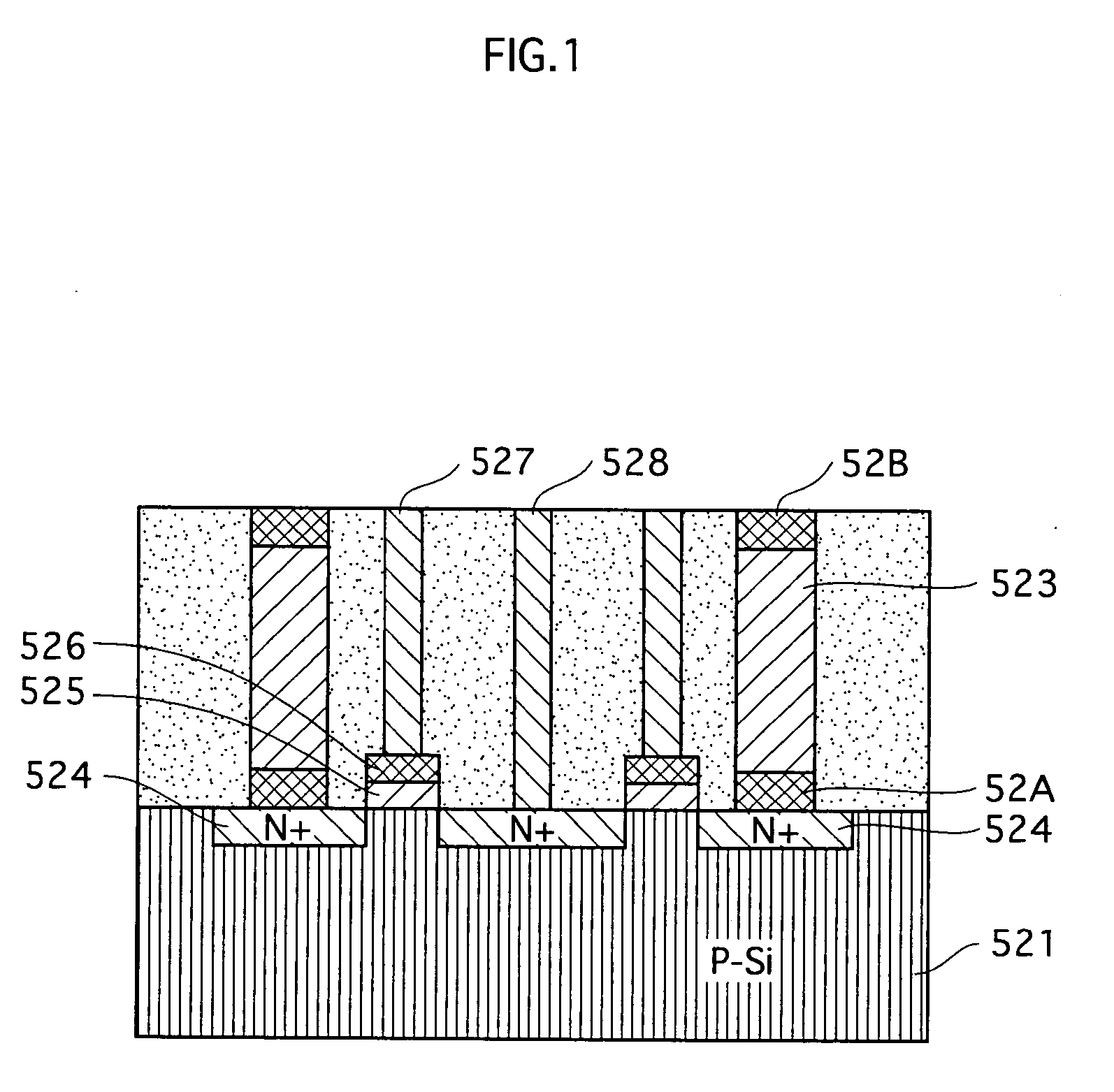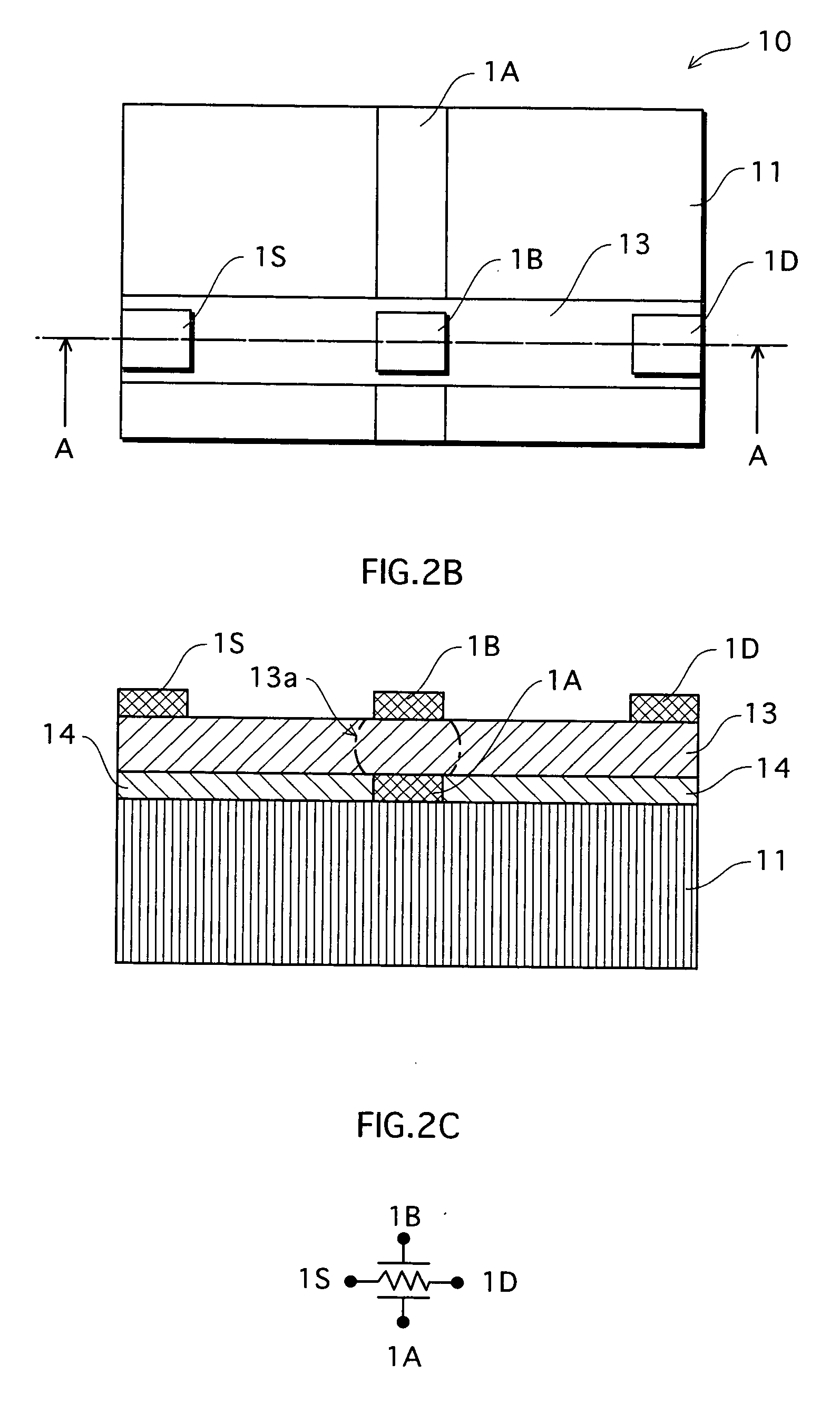Variable resistance device made of a material which has an electric resistance value changing in accordance with an applied electric field and maintains the electric resistance value after being changed in a nonvolatile manner, and a semiconductor apparatus including the same
- Summary
- Abstract
- Description
- Claims
- Application Information
AI Technical Summary
Benefits of technology
Problems solved by technology
Method used
Image
Examples
embodiment 1
1. Embodiment 1
[0074] A variable resistance device 10 according to Embodiment 1 is described below in reference to FIGS. 2A to 2C. FIG. 2A is a plain view showing relevant parts of the variable resistance device 10; FIG. 2B is a schematic cross section of the variable resistance device 10 along the line A-A; and FIG. 2C is an equivalent circuit diagram of the variable resistance device 10.
1.1 Structure of Variable Resistance Device 10
[0075] The variable resistance device 10 has a layered structure in which a 1st electrode 1A and a planarizing layer (for example, a silicon oxide layer) 14 are formed on the main surface of a substrate (for example, a silicon substrate) 11, and a variable resistance layer 13 is formed on top of the 1st electrode 1A and planarizing layer 14, as shown in FIGS. 2A and 2B. On the surface of the variable resistance layer 13, a 2nd electrode 1B, a 3rd electrode 1S and a 4th electrode 1D are formed. As shown in FIG. 2A, the 3rd, 2nd and 4th electrodes 1S, 1...
modification 1
[Modification 1]
[0093] A variable resistance device 20 according to Modification 1 is described next in reference to FIGS. 3A and 3B.
[0094] As shown in FIG. 3A, the variable resistance device 20 according to the present modification differs from the above-mentioned variable resistance device 10 in the positions of 3rd and 4th electrodes 2S and 2D composing a read electrode pair, and this is a characteristic feature of the variable resistance device 20. In the variable resistance device 20, the 3rd and 4th electrodes 2S and 2D are formed on top of a substrate (e.g. a silicon substrate) 21 along with a 1st electrode 2A, and a planarizing layer (e.g. a silicon oxide layer) 24 is formed to fill the space between the 3rd and 1st electrodes 2S and 2A and between the 1st and 4th electrodes 2A and 2D. Formed on top of the electrodes 2S, 2A and 2D and the planarizing layer 24 is a variable resistance layer 23, on which only a 2nd electrode 2B is superimposed. As a constituent material of th...
modification 2
[Modification 2]
[0099] A variable resistance device 30 according to Modification 2 is described next in reference to FIGS. 4A and 4B.
[0100] As shown in FIG. 4A, the variable resistance device 30 according to the present modification has the same positioning and structure as the variable resistance device 10 of Embodiment 1 in terms of a 1st electrode 3A formed on a substrate 31, a planarizing layer 34, a variable resistance layer 33, 2nd and 3rd electrodes 3B and 3S. The variable resistance device 30 of the present modification differs from the above variable resistance device 10 in the position of a 4th electrode 3D.
[0101] In the variable resistance device 30 of the present modification, the 4th electrode 3D is positioned between the substrate 31 and the variable resistance layer 33, as with the 4th electrode 2D of Modification 1 above. In the horizontal direction in FIG. 4A, the 3rd electrode 3S is positioned to the left of the 2nd electrode 3B on the surface of the variable res...
PUM
 Login to View More
Login to View More Abstract
Description
Claims
Application Information
 Login to View More
Login to View More - R&D
- Intellectual Property
- Life Sciences
- Materials
- Tech Scout
- Unparalleled Data Quality
- Higher Quality Content
- 60% Fewer Hallucinations
Browse by: Latest US Patents, China's latest patents, Technical Efficacy Thesaurus, Application Domain, Technology Topic, Popular Technical Reports.
© 2025 PatSnap. All rights reserved.Legal|Privacy policy|Modern Slavery Act Transparency Statement|Sitemap|About US| Contact US: help@patsnap.com



